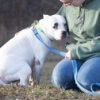Dogs and cats will sometimes eat socks, rocks or other objects, which may result in a variety of problems for both you and your pet. Not only can your possessions be destroyed or damaged, but objects such as clothing and rocks can produce life-threatening blockages in your pet’s intestines. Eating non food items is called pica. A specific type of pic is stool eating (either their own or that of another animal) and, while not necessarily dangerous to the animal, is probably unacceptable to you. Stool eating is called coprophagy.
The causes of pica and coprophagy are not known. Many ideas have been proposed by various experts, but none have been proven or disproven. Such behaviors may sometimes be attention-getting behaviors. If engaging in one of these behaviors results in some type of social interaction between the animal and his owner (even a verbal scolding) then the behavior may be reinforced and occur more frequently. These behaviors may be attempts to obtain a necessary nutrient lacking in the diet, although no nutritional studies have ever substantiated this idea. They may also stem from frustration or anxiety. It’s possible behaviors begin as play, as the animal investigates and chews on the objects, then subsequently begins to eat or ingest them.
It has been suggested that coprophagy is carried over from the normal parental behavior of ingesting the waste of young offspring. Some experts believe coprophagy occurs more often in animals who live in relatively barren environments, are frequently confined to small areas and/or receive limited attention from their owners. Coprophagy is fairly common in dogs, but is rarely seen in cats and is seen more often in dogs who tend to be highly food motivated. It’s also possible that dogs learn this behavior from other dogs.
Because pica and coprophagy are behaviors thatare not well understood, stopping them may require assistance from an animal behavior professional who works individually with owners and their pets. A variety of specialized behavior modification techniques may be necessary to resolve these problems.
Coprophagy Suggested Solutions
- Because the cause of coprophagy isn’t known, there are no techniques or solutions that are consistently successful. The following techniques may, or may not be, effective in resolving the problem.
- Treat your pet’s food with something that causes his stool to have an aversive taste. A commercial product called “For-Bid” is available through your veterinarian, or the same result may be achieved by using the food additive, “MSG.” Based on owners’ reports, both of these products appear to work in some cases, but not always. Before using either of these products, please check with your veterinarian.
- Treat your pet’s stools directly with an aversive taste by sprinkling them with cayenne pepper or a commercial product, such as “Bitter Apple.” For this method to be effective, every stool your
pet has access to must be treated in order for him to learn that eating stools results in unpleasant consequences. Otherwise, he may discriminate by odor which stools have been treated and which have not. - Any time your pet goes outside, he must be on a leash with you. If you see him about to ingest some stool, interrupt him by using a squirt bottle or shake can (only for pets who aren’t afraid of loud noises) then give him a toy to play with, instead. Praise him for taking an interest in the toy.
- The simplest solution may be to clean your yard daily in order to minimize your pet’s opportunity to eat his stools.
- To stop a dog from eating cat feces from a litter box, install a baby gate in front of the litter box area. Your cat shouldn’t have any trouble jumping over it, while most dogs won’t make the attempt. Or, you could place the box in a closet or room where the door can be wedged open from both sides, so your cat has access, but your dog doesn’t. Any type of environmental “boobytrap”
to stop a dog from eating cat feces from a litter box must be attempted with caution because if it frightens your dog, it’s likely to frighten your cat, as well.
What Doesn’t Work
- Interactive punishment (punishment that comes directly from you, such as verbal scolding) is usually not effective because it may be interpreted by your pet as attention. With interactive punishment, many animals learn to refrain from the behavior when their owner is present, but still engage in the problem behavior when their owner is absent.
- Punishment after the fact is never helpful. Animals don’t understand that they’re being punished for something they did hours, minutes or even seconds before. This approach won’t resolve the problem and is likely to produce either fearful or aggressive responses from your pet.
Health Risks
If your pet is parasite-free and is eating only his own stools, he can’t be infected with parasites by doing so. If your pet is eating the stools of another animal who has parasites, it may be possible, although still unlikely, for your pet to become infected. Some parasites, such as girdia, cause diarrhea, and most coprophagic dogs ingest only formed stools. There is also a delay period before the parasites in the stools can re-infect another animal. Most parasites require intermediate hosts (they must pass first through the body of another species, such as a flea) before they can re-infect another dog or cat. Thus, your pet is much more likely to become infected with parasites through fleast or by eating birds and rodents than by coprophagy.
Most parasites are also species-specific, meaning that dogs cannot be infected by eating cat stools. Health risks to humans from being licked in the face by a coprophagic animal are minimal. For more information, please contact your veterinarian.
Pica
Pica can be a serious problem because items such as rubber bands, socks, rocks and string can severely damage or block an animal’s intestines. In some instances, the items must be surgically removed. Because pica can be potentially life-threatening, it’s advisable to consult both your veterinarians and an animal behavior professional for help.
Suggested Solutions
- Make the objects your pet is eating taste unpleasant with some of the substances mentioned above.
- Prevent your pet’s access to these items.
- If your pet is food-oriented, it may be possible to change to a low-calorie or high fiber diet to allow him to eat more food, more often, which may decrease the behavior. Check with your veterinarian before changing your pet’s diet.
- If you suspect that anxiety or frustration is the reason for pica, the cause of the anxiety or frustration must be identified and the behavior changed by using behavior modification
techniques. - Sometimes pica is an attention-getting behavior. If this is the case, try to startle your pet with a loud noise or a spray of water when you catch him ingesting the items. If possible, avoid letting
him know that the startling noise or spray came from you, and be sure to praise him when he leaves the items alone. Try to set aside 10-15 minutes twice a day to spend with your pet, so that he doesn’t need to resort to pica to get your attention. - If pica is a play behavior, keep plenty of toys around for your pet to play with. Cats, especially, tend to play with string, rubber bands and tinsel, and ultimately ingest them. Keep these items out
of reach and provide a selection of appropriate toys (see “Cat Toys and How to Use Them” and “Dog Toys and How to Use Them”).
What Doesn’t Work
- Interactive punishment (punishment that comes directly from you, such as verbal scolding) is usually not effective because it may be interpreted by your pet as attention. With interactive punishment, many animals learn to refrain from the behavior when their owner is present, but still engage in the problem behavior when their owner is absent.
- Punishment after the fact is NEVER helpful. Animals don’t understand that they’re being punished for something they did hours, minutes or even seconds before. This approach won’t resolve the problem and is likely to produce either fearful or aggressive responses from your pet.








